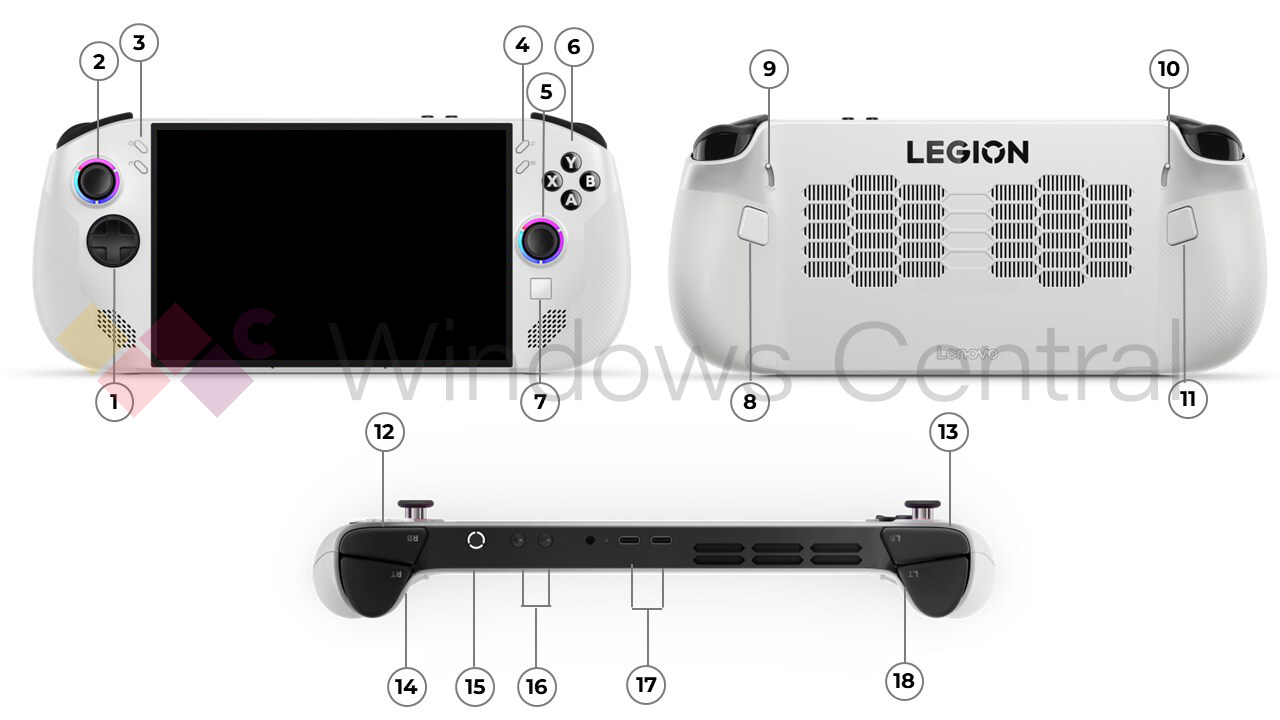We were the first outlet to report on the Lenovo Legion Go “Lite” (later revealed as the Lenovo Legion Go S) earlier this year, and now we have some more shiny new details for you. Most notably, the first official renders of the new product, which confirms earlier leaks of a white chassis.
Shared by Videocardz previously, the Lenovo Legion Go S is expected to use the new AMD Ryzen Z2 platform, notably its Z2G “Rembrandt” config. This would contribute to the idea that the Lenovo Legion Go S is supposed to be a more affordable option. Indeed, it has dropped a lot of the “bells and whistles” on the Lenovo Legion Go, dropping the detachable sticks, the kickstand, and extra back buttons for a more ASUS ROG Ally-like profile.
CYBER MONDAY FLASH SALE: Get the Lenovo Legion Go for $200 OFF @ Amazon while stocks last.
The official renders from Lenovo are below, shared and confirmed as genuine by our amazing and awesome sources.
As you can see from the render, it looks a lot like the ASUS ROG Ally, complete with the white colorway. The “white” color is likely to denote its more “affordable” nature. The Z2G “Rembrandt” chip has “Zen3+” cores which makes it less powerful than the Z1 Extreme we have now in devices like the Lenovo Legion Go and ASUS ROG Ally, which have Zen4 cores.
RELATED: Every PC gaming handheld owner needs this cheap accessory
The APU should make the Lenovo Legion Go “S” significantly cheaper than the current roster, which RRPs at anywhere between $499 and $599. All the bells and whistles on the Lenovo Legion Go base model pushes it all the way up to $699 at RRP (although the Lenovo Legion Go is presently on sale for $200 off at Amazon), but none of those bells and whistles are present here.
What we can see is a large honeycomb-style reverse vent which is not dissimilar to its predecessor. While it’s difficult to infer size from this render alone, it’s most likely going to use a smaller display to shave some dollars off the RRP. It’s widely expected that this could retail anywhere around the $399 to $449 mark, given Lenovo’s eagerness to get something more affordable into the market. Lenovo has retained the double USB-C ports, however they both seem to be on the top of the device now. Interestingly, there seems to be a “nub” to replace the full touchpad, similar to Lenovo’s popular TrackPoint cursor you see on some of their laptops. RGB lights are still in, but Lenovo seems to have moved its Xbox “menu and view” keys up to the top of the device, rather than down off to the left (thank you, thank you.)
The Lenovo Legion Go is my preferred PC gaming handheld right now owing to its versatility as a laptop replacement on top of being a powerful gaming handheld in its own right. But if I had to guess, devices like the ASUS ROG Ally and especially the Steam Deck have likely achieved much bigger market penetration owing to more affordable options. Among other things. The ASUS ROG Ally has some undeniable advantages over the Lenovo Legion Go, with a lighter-weight design, more ergonomic grips and triggers, and maturing software. Lenovo seems keen to catch up, though, with a decent cadence of updates to its software and driver suite, and hardware iterations like the Lenovo Legion Go S.
What remains to be seen is whether the Lenovo Legion Go “2” will retain some of the features of its predecessor. What we’ve seen here is that Lenovo has dropped some of the Legion Go’s unique features, like the Switch-like detachable sticks (one of which can double as a mouse), as well as its Surface-like kickstand. Will the more powerful Z2 Extreme Legion Go 2 drop them as well? I for one, hope not. But given the decent bump in power and most likely battery efficiency, all those added bells and whistles could add added alarm bells to the price.
Expect to find out more about this device and other AMD Z2 platform PC gaming handhelds from Lenovo’s competitors at CES 2025, which as always, is set for January 2025 fresh out of Las Vegas.






